"The opening for Gregory Nava's American Family: Journey of Dreams' premier episode is as much a cinematic definition of the PBS drama, itself, as it is a lesson in storytelling, technology and filmmaking. The 38-minute opening shot breaks all of the rules by having the camera follow multiple characters, crisscrossing lines, effortlessly entering and exiting interiors and exteriors, capturing simultaneous action at 360-degree angles and seamlessly transitioning between the present and past.
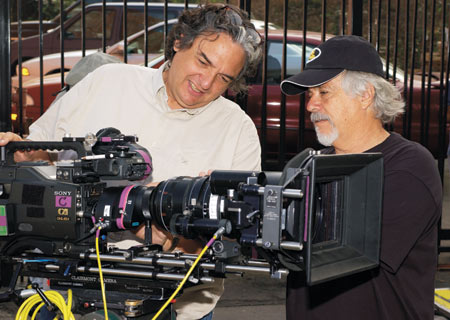
Director Gregory Nava (left) and cinematographer/DGA director member Rey Villalobos
This technique is rare, if not unheard of in television production today. Then again, so is the notion of a show shedding its episodic skin to be reborn as a miniseries in its second season. The English drama, Upstairs, Downstairs (1971-1974) was the first to make the unique episode to miniseries switch. The similarities between the two shows, however, end there.
Written by Gregory Nava, Barbara Martinez Jitner and Lorenzo O'Brien, the 13-episode season of American Family chronicles the multigenerational saga of the Gonzalez family's pursuit of the American Dream over four storylines; Homefront 2003, the Iraq War 2003, the 1990s and the Mexican Revolution. The entire 75-day television shoot (intentionally scheduled like a film production) was also shot using a 24P High Definition three-camera setup.
"When we did the first season of American Family, I conceived the show as 22 little movies. But then, 9/11 happened. We did an episode about the oldest son, who's a doctor, deciding he wanted to enlist in the Army," said Nava, the show's creator/ executive producer and director of the feature films My Family/Mi Familia, Selena and Why Do Fools Fall in Love?
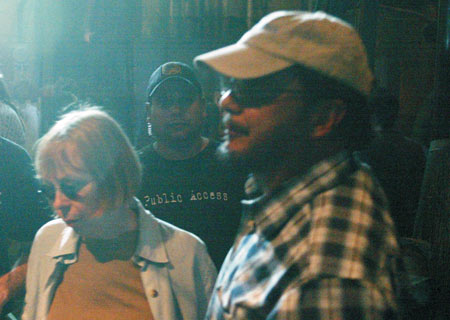
(Below) Director Charles Burnett and Lynn Whitfield (top) UPM Ann Kindberg and 1st AD Tom Archuleta
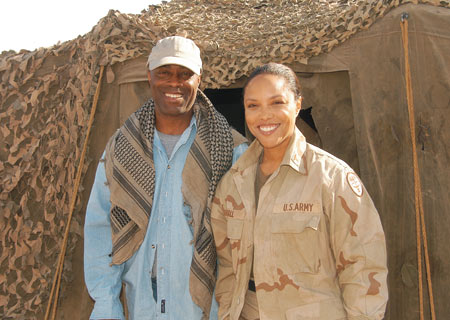
"Then when we were planning the next season, the war in Iraq happened. That's when I decided to re-cast and make the show a miniseries with a beginning, middle and an end, instead of episodic."
To pull off this undertaking, Nava reenlisted the help of producer/UPM Ann Kindberg, first assistant director J. Tom Archuleta, director of photography and DGA director member Rey Villalobos, and others from the show's first season to ensure that the production would run as smoothly and efficiently as humanly possible.
"This miniseries was an enormous, logistical giant. It was far more complicated than shooting a feature," Nava explained. "I shot my first feature, El Norte (a 2 1/2-hour movie) in 75 days. In that same amount of time, we shot a 9 1/2-hour miniseries.
"Most movies and miniseries also only follow one time line. Our show had four stories that were intercutting with four different camera looks, four different wardrobes and four different production designs. We weren't only shooting out of sequence, we were shooting out sequence on four stories. It was more than out of sequence; It was out of sequence cubed."
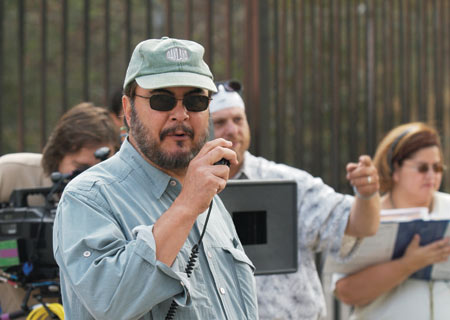
1st AD Tom Archuleta
American Family's production equation was further complicated by a number of factors, including actor availability, shooting in both the United States and Mexico and the lack of time and money.
Nava, however, picked up a few tricks and shortcuts last season, which he used for this year's miniseries. The production week ran from Wednesday through Sunday and the show was shot on HD instead of film to save money. The crew also capitalized on the time crunch by shooting the series with three cameras to decrease setup time and increase shot options and coverage.
The production day, which ran an average of 12 hours, began with a two-hour closed-set rehearsal with the directors and actors. Next, the crew arrived and the actors ran through the entire day's work to set blocking and to determine how each scene would be lit and lensed. A shot list was then prepared based on the rehearsal. The actors were costumed, reported to hair and makeup and returned to record the entire scene without stopping.
Villalobos, who directed the episode, "Glass Ceiling," for the show last season and returned as the miniseries' director of photography, said the experience was like "shooting a feature in live television."
"I'm in video village, which is blacked in. I'm hooked up to the camera and have headphones on to talk to the camera operators and assistants. We're crossing lines and there's no place to put the lights," said Villalobos, who used 8mm and Super 16mm film, and experimented with source lighting, steadicam, dolly, crane and handheld shots to create the unique look of each time period and the overall tone of the show.
"We watched the rehearsal to figure out what to do beforehand, but if something good happened, we changed in the middle of the scene. And if we had a problem while we were running the whole thing, we would go back, get the little pieces, swing in or go in for a close up. You can do a lot of work this way and it gives the scene so much energy."
And like live theatre, the action was continuous, watched from afar on three color monitors in the video village; an 8x8x8 black box made of duvatine. The HD cameras, which are more sensitive to light than film cameras, ran continuously. And, taking Nava's cue, "cut" was rarely called.
"With Hi-Def, you have an hour load at about $60 a piece, and it takes five seconds to switch the tape. We'd turn the camera on the minute the actors got on the set, and we'd even shoot the rehearsals. And when we were done with one take of the scene, we'd tell the actors what changes to make, then hurry back to our marks and do it again," Nava said. "I wouldn't stop, because the minute you stop, everybody loses their energy and the actors lose their emotional heat. Shooting without cutting gave the actors a lot of freedom and made them feel that their work was being respected. It was amazing how real the performances were. It was more organic."
Having been very critical of HD, Charles Burnett, who directed a distinct segment of the production relating to the Iraqi war, began to see the medium in a different light once he saw what Nava, Villalobos and the crew were able to achieve on set with the cameras.
"When I did Nat Turner on HD, we made all of our color-timing adjustments in post. On American Family, we did everything on location. They were trying to push high definition by doing all these experiments with the camera and that was really interesting. It's something I took with me and can now use," he said. "That's the difference between directing a project in HD and directing an ordinary film. In the first sense, you're not thinking about technical things. You're just doing your work. But in a film when you're doing all of these things with the HD camera, a part of your time is observing that on the set."
Villalobos, who had never shot with HD before directing an episode last season, shot numerous tests and literally dissected the Sony 900 camera to figure out "what it could and couldn't do" during pre-production. He also made some discoveries about the camera when he was shooting on the set and on location.
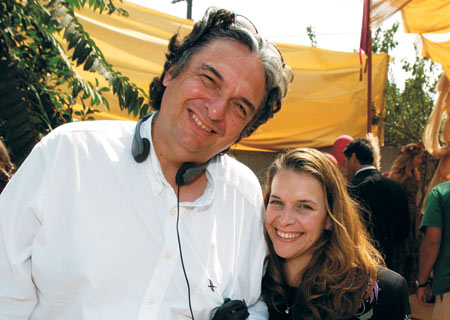
Gregory Nava with producer/director Barbara Martinez Jitner on the set
"The great thing about shooting HD is that I could choose what I wanted each segment to look like. I could time the show myself right there on the spot and make it look like I wanted it to look. In that way, it's better than film," he said. "On the other hand, HD is harder to shoot than film, because the cameras are cumbersome. They're longer and harder to get through doorways and into small spaces. HD tape also doesn't hold overexposure as well. You have to light it and use diffusion and filters to not make it look so crisp, to get it away from that tapey look."
To achieve the ghostly, grainy look for Nava's Mexican Revolution storyline, the big battle sequences were shot in the formats of HD and Super 8 videotape with 65% of the color desaturated out of the picture.
For the Iraqi War 2003 section, handhelds were used with added yellow color to imitate the feel of a documentary. The 1990 sequences, a collection of the oldest son's memories, were printed warm to express the nostalgic nature of the scenes. And natural lighting was used to create the realistic look for Homefront 2003.
And contrary to popular belief, HD is not faster to shoot than film for a DP, added Villalobos.
"The lighting takes the same amount of time. You're working with a lot of electronics and sometimes the assistants can't shoot it fast enough or the monitors aren't working. But if it's film, it's me and a camera. And if I want to get a close-up of a guy jumping off a horse, I can run over there and get it with no problem," he said. "By the same token, people usually can't afford to buy thousand footers of film and run three cameras at the same time. So, there are pluses and minuses for shooting either film or HD."
AD Archuleta also found HD to be an "overall good tool" for the production. To prepare for the camera's electronic limitations, he scheduled time for the camera department to set up and make location moves.
"It took 30-45 minutes to warm up the cameras in the morning. Also, if you moved the play station in between scenes, it took 45-60 minutes before the cameras were up and running again," he said. "Everything had to be planned very precisely. You couldn't waste time. You had to take into account the time between moves."
As the 1st AD for the show, Archuleta spent the majority of the day running the set. Back at the production offices, UPM Kindberg confirmed what actors were available and second assistant director, Ruben Garcia, broke down the new scripts as they came in and prepped with the next day's director.
"This show was extremely complex to schedule. The actors' availability was always an issue and there were times when we would do five episodes in a day," said Kindberg. "Also none of the actors were really exclusive to our show. I think there were five actors who we knew were always on other shows and that made scheduling extremely difficult. We might hire someone for three episodes, but because the time that we needed them to shoot was spread over so much time, they might book a job in between. It was a constant juggling act."
For that reason, Archuleta kept a board in his office solely to track what actors were or weren't available on any given production day.
"I had to constantly tell people that the schedule was in a state of flux," he said, citing that script rewrites and location changes also affected the schedule. "We could never schedule more than two weeks at a time. Many times, the shooting almost caught up with the schedule, but we were always able to pull it off. It was extremely challenging."
The challenges for the shoot, however, weren't only logistical. To ensure that the vision for the miniseries remained united, Nava met with directors Charles Burnett and Barbara Martinez Jitner frequently to discuss their work and how their segments completed the larger picture of the miniseries. Once production began, each director worked independently and Nava used the script and videotape dailies as guides to keep their individual and collective visions aligned.
"The thing that kept us all in lock step was the script. In a way, we communicated to one another through the structure," said Burnett. "Usually when you do a film, you know the beginning, middle and end, and it's inherent in the structure that it has a complete story. But on American Family, you had to remember that what completed the story in Iraq were the other stories and vice versa. The stories didn't stand alone, so you had to keep in mind that there were moments that you had to capture and you had to pay close attention to how the scene opened and closed."
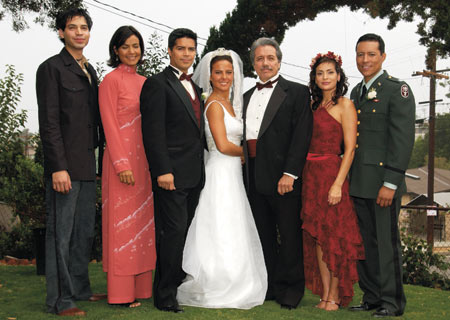
From left: Parker Torres, Rachel Ticotin, Esai Morales, Kate de Castillo, Edward James Olmos, Constance Marie and Yancey Arias in American Family
"When I was looking at the section I was doing, I was thinking that it was filled with nostalgia, almost like a haiku poem. I wanted to condense all of the emotion in it," said Martinez Jitner. "It was great to see how it all cut together."
Woven together with the help of a team of seven editors, the show logged approximately 2,250 hours of footage. Initially, PBS didn't expect immediate delivery for the shows but the team was able to cut together scenes from the 13 episodes as they got them in. American Family began shooting in February, and the first show aired in April.
"We started out as the first all-Latino show on English-language television. We became the first show in the history of television to deal with war while the war is going," said Nava. "All I ever wanted to do was to do a show that really reflected the changing face of America and what's going on in our country. This show is an original."